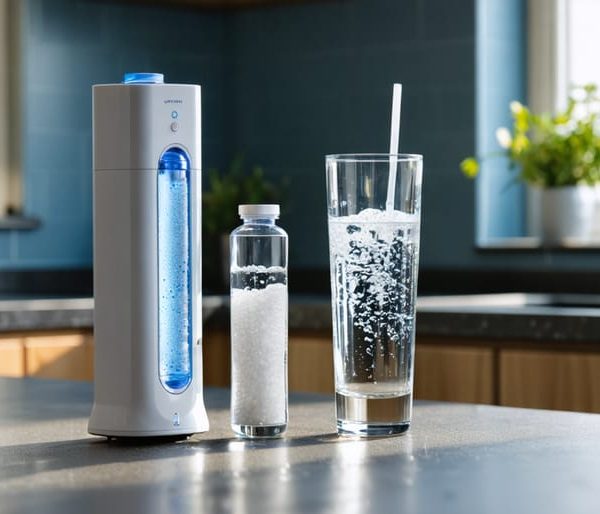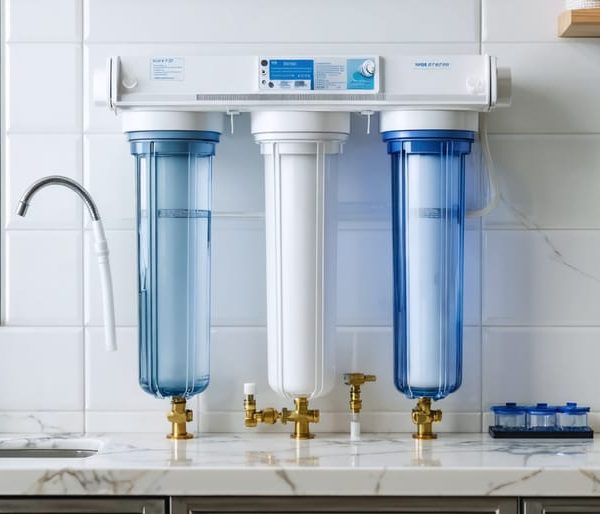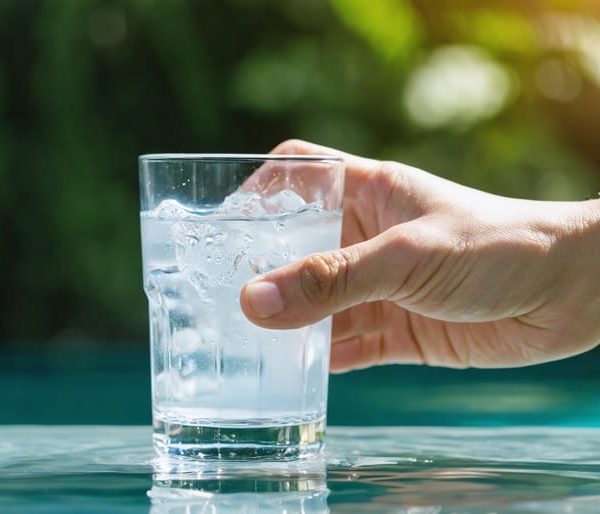One of the most common types of water filters for homes is the activated carbon filter. Activated or catalytic carbon filtration systems are effective in filtering contaminants and are more affordable than the close competitor reverse osmosis, which produces the purest drinking water. A close third is the Ceramic filtration system, which uses the fine physical barrier method to filter water.
Other common types of water filters are alkaline water ionizer filtration, ultraviolet light filtration, water distillation filtration, and activated alumina filtration.
With so many types of water filters available, it is hard to decide which one is best for your home. Let’s try to understand how the different types of water filters work before you make a decision.
Activated Carbon Filtration
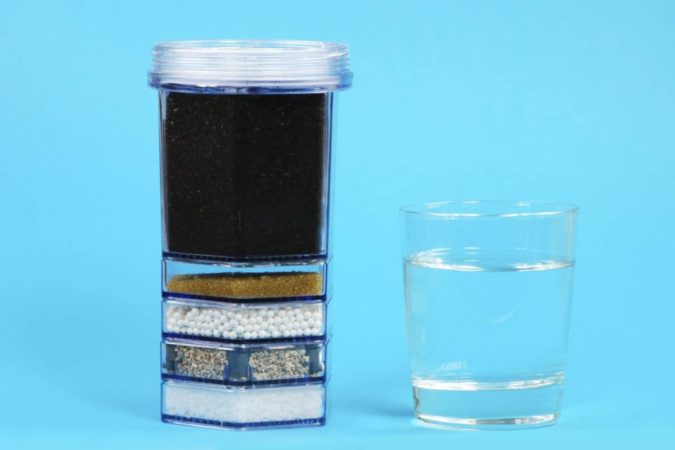
The activated carbon filtration system is a common type of water filtration system that extracts or removes organic compounds alongside free chlorine from the water. This makes the water eligible for distribution or for manufacturing use.
This filtration system rids potable water of organics such as fulvic and humic acid. The system also hinders the chlorine present in the water from having a chemical interaction with the acids and, in the process, creates trihalomethanes, which are prominent carcinogens.
The carbon water filter has one thing in common with other water filters; they can’t eliminate every form or type of water contamination. For example, contaminants such as fluoride, microbes, sodium ions, and nitrates cannot be flushed out by activated carbon filtration.
This type of water filter can’t soften water, and it takes a very particular kind of activated carbon system to rid the water of heavy metals such as lead.
How Does It Work?
Activated carbon water filters work in two ways:
- Dechlorination
- Extraction of organic compounds
By Dechlorination
This process of water filtration functions by extracting chlorine with minimal damage to the carbon. It is a speedy process and usually has high flow rates. This process also needs a wide surface area, and the organics in the water will fill up at last and obstruct the pores of the carbon.
The carbon filtration system will be due for replacement in the long run because its dechlorinating ability will gradually decline. Expended carbon can be re-activated, but such filters are best used in the treatment of wastewater.
By Extraction of Organic Compounds
During this water filtration process, organic matter and chemicals are kept inside through adsorption. This process relies on five essential factors:
- Physical elements of the activated carbon (surface area and pore size distribution)
- Chemical constituents of the carbon source (quantity of hydrogen and oxygen)
- The chemical elements and concentration of the contaminant
- Water acidity/alkalinity and temperature
- The duration of exposure of activated carbon filter to the water (called empty bed contact time).
Reverse Osmosis Systems
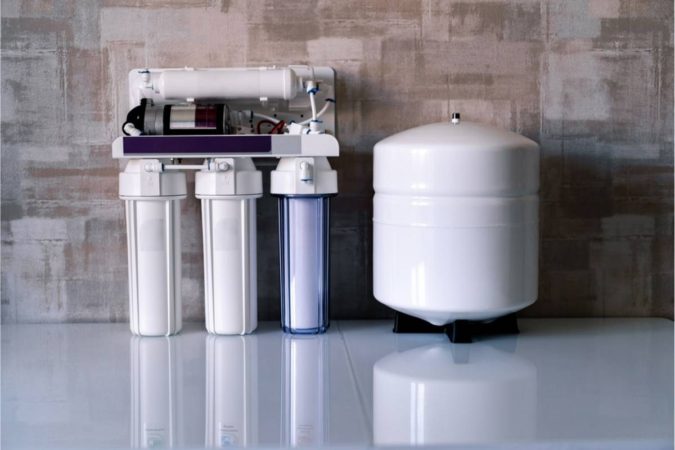
One of the most common types of water filters is the reverse osmosis system. The process flushes contaminants from the untreated water by pressurizing it through a semi-permeable membrane.
Water flowing goes from the more contaminated side of the reverse osmosis membrane to the lesser contaminated side, providing potable water (the permeate) in the process. The remnant water from this filtration process is known as brine or waste.
The semi-permeable membrane contains tiny pores that hinder contaminants but permits the flow of water molecules. This filter prevents the contaminants from gaining access to the less contaminated side of the membrane.
For instance, if we are using saltwater during this filtration process, a quantity of saltwater is pressurized through the semi-permeable membrane, blocking the salt and permitting just the clean water to flow through.
How Does the RO System Work?
The reverse osmosis systems work via the following filtration methods:
By Pre-filtration
This stage involves using a carbon filter and a sediment filter to eliminate chlorine and foreign elements. In addition, this stage ensures that they don’t block the membrane of the reverse osmosis filter system.
By Extraction of the Dissolved Particles
At this stage, there is a removal of the dissolved solids that settled down in the water. These particles are usually too small in size, and one even can’t see them with the aid of an electron microscope.
Storage
After the water has been pre-filtered and the nearly invisible particles extracted, the water flows into a reservoir where it’s stored. Reverse osmosis filtration continues the prefiltration and particle-extraction process until the reservoir is full and then it stops.
Post-filtration
At this stage, when your faucet is on, your filtered water flows from the reservoir. Then, the water passes through a post-filter to complete its water purification before it comes out via your tap.
Alkaline Water Filtration
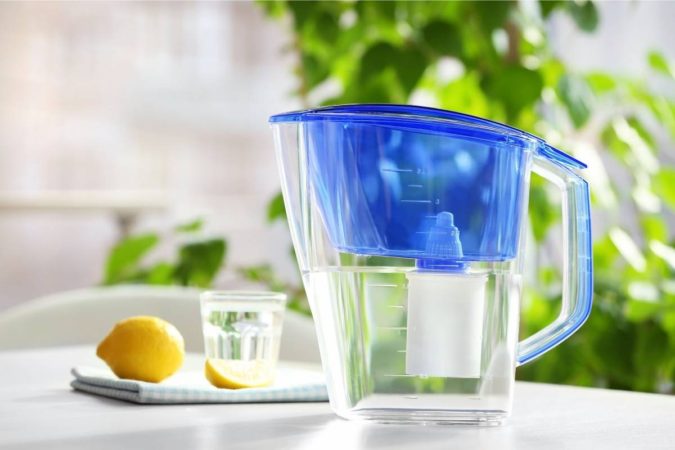
The alkaline water filters treat water by raising the pH of the water to an alkaline level. Alkaline water is softer than acidic water, so one can use water ionizers in locations with hard water to aid with the scale effects in the plumbing system.
How Does It Work?
The alkaline water filter uses electrolysis to segment the water into two sections according to the molecular charge of the particles contained in that supply of water. Molecules with a negative charge are attracted to the anode. On the other side, the molecules with a positive charge are drawn to the cathode.
Both charges determine the alkalinity or acidity (pH level) of the water. Alkaline water is believed to be healthier than acidic water. Therefore, it makes the water quality better.
Ultra Violet Filters
One can utilize this water purification system to disinfect drinking water, process water, wastewater, and surface disinfection.
Ultraviolet filters are a safer and more affordable water filtration system used to disinfect water for industrial applications. A UV water filter is applicable anywhere pure, healthy, and microbe-free water is needed and where there is a significant tendency for water to be contaminated before it comes out as tap water.
The best part about this filter is that it destroys 99.9% of microbes in the water without affecting the water’s tastes or smells.
How Does It Work?
A UV filtration system works by using ultraviolet light of wavelength 253.7 nanometres to disinfect or neutralize organic compounds in the water, such as viruses, algae, mold, bacteria, etc. This prevents them from propagating in the water. In addition, the UV filters decimate the DNA of these microbes, which renders them inactive and kills them.
Their DNA is essential to the living functions of these microorganisms, the chief of which is reproduction in this context.
The UV light is produced by the sun in small quantities, but it can be created in more concentrated forms via high mercury discharge lamps, also referred to as UV lamps.
Ceramic Filtration
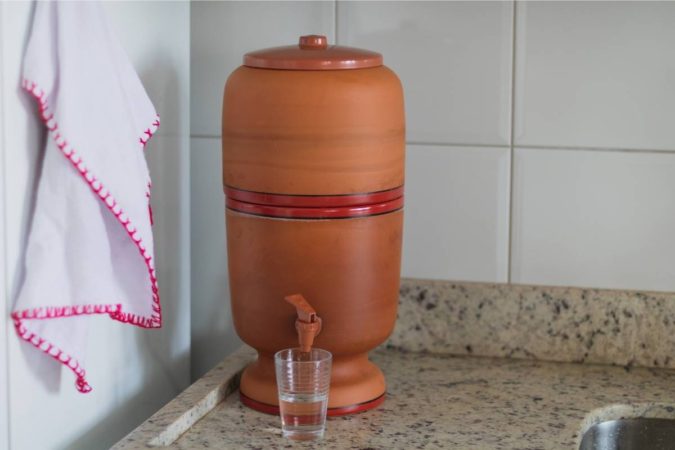
This type of water filter is affordable and has a good efficiency level. They depend on the minute size of the pore in the ceramic to filtrate sediments and microorganisms from the water. It’s the simplest water treatment method.
They are very suitable for developing nations. Furthermore, backpackers popularly use portable ceramic water filter systems as it allows them to drink water on the go.
The two most popular types of ceramic water filters are the pot-type and candle-type filters.
Ceramic water filter systems are made up of a porous ceramic filter attached to the top of a plastic or ceramic receptacle. Untreated water is poured into the upper container. It goes through the filter(s) into the receptacle below. The lower receptacle is typically fitted with a tap.
How Does It Work?
Just like other types of water filters, this particular filter extracts organic contaminants that are bigger than the pore size of the filter or drain material.
Protozoa, microbial cysts, and bacteria are extracted. However, these drinking water filters cannot extract viruses because they are comparatively small to go through the purified side. These water filters are usually treated with a form of silver that’s impossible to leach away. This silver aids in neutralizing bacteria and hindering the development of algae or mold in the filter’s body.
Ceramic filters do not extract chemical contaminants, but certain ceramic filters (the candle filters) feature a very effective activated carbon core within the cartridge of the filter to lessen metallic and organic contamination agents.
Water Distillation Filtration
Water distillation filtration is the first known system of water treatment or water purification. It is used globally to enhance the quality of drinking water sources and extract the impurities contaminating them.
This filter system is also used to make saltwater drinkable through a process of desalination.
How Does It Work?
This water filter requires two things to function:
- A heat source
- Condenser
This water filtration process uses heat to boil or vapourize untreated water to evaporate it, thereby separating it from the various agents of contamination. These harmful contaminants are usually on the surface or groundwater. Because water has a low boiling point, it begins to vapourize very quickly. Once the temperature has reached a suitable level, it is maintained to sustain the evaporation of water while preventing the vapourization of other elements in the water. The vaporized water is then channeled into a condenser, where it cools down and becomes liquid again. Finally, it flows into another container where it will be stored as drinking water or for other uses.
There are also solar-powered distillers, eliminating the need to spend much on acquiring heat sources for the distillation process. It is also more friendly to the environment than the conventional heat sources used.
Types of Water Distiller
Household Water Distiller
This is a popular type of water distiller. You can easily install these under sink filters in your office or on your kitchen table.
To use, pour a desired quantity of water into the distiller, and the water undergoes distillation, collection, and filtration into a reserved place for use.
Plumbing Distiller
These distillers can be set up in your household plumbing system or any faucet. Faucet mounted filters distill your water whenever you need it. It’s a very affordable way to distill your usable water. It requires periodic maintenance, which involves removing the accumulated sediments at the base of the boiling chamber.
Commercial Distiller
This is a multiple-effect distiller, which is used industrially. It can provide any quantity between 75 gallons to millions of gallons of distilled water daily. They have several boiling chambers, which enables them to distill more quantity of water at a time.
Activated Alumina Filtration
Unlike other drinking water filters, it assimilates contamination agents instead of extracting them. The efficiency level of the activated alumina filtration system relies on:
- The type of contaminant
- The design of the equipment
- The quality of the water
- The characteristics of the alumina
Activated alumina makes a powerful water filtration system for untreated water with many solids or a high concentration of sulfates.
A disadvantage of this filter is that its regeneration process requires a potent acid and certain liquids that are not safe for household storage or operation.
How Does It Work?
By Adsorption
The activated alumina water filter has a compact bed of granular activated alumina. When water flows through the equipment, the granules of the activated alumina water filter adsorbs the agents of contamination. The potency of the activated alumina hinges on the transformable components of the contamination agent one needs to get rid of.
For instance, under particular circumstances, adding chlorine to the untreated water will transform arsenic into a form with a greater tendency that be easily absorbed.
The water pH level also determines the potency of treatment by activated alumina. Generally, the pH should fall below 8.5. For specific contaminants such as fluoride, a pH level of 5-6 is alright. In contrast, arsenic requires a pH level of 7. It is also essential for the water to undergo pre-treatment to lower the pH to ensure the activated alumina treatment is potent.
Unfiltered water concentrated with suspended solids should be pre-treated with a specialized filter to stop it from blocking the filter bed.

